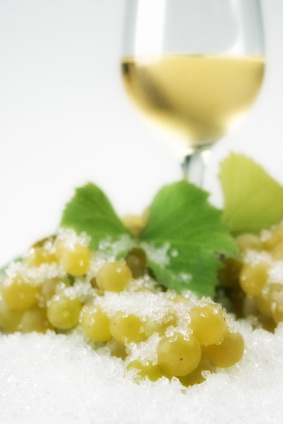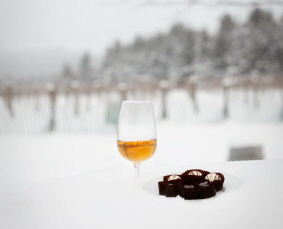How do you serve icewine?
Serve icewine chilled; an hour or two in the fridge will allow it to reach the ideal drinking temperature of 10C-12C. The traditional time to serve it is at the end of the meal, when most people already feel full.
Many producers feel that icewine shouldn’t be called a dessert wine, as it stereotypes the wine into being consumed only at the end of a meal, when most people are already full.
Conversely, French sauternes is also served at the beginning of a meal with dishes such as foie gras and cheeses. Icewine works equally well, and it also can handle main entrees such as seafood, lobster, scallops and meals with a caramelized preparations due to its texture, viscosity  and weight.
and weight.
If served with dessert, a half bottle will serve six to eight people with about two ounces apiece: the wine is so sweet that a little goes a long way. But just because the pour may be small, the glasses don’t have to be. Skip those tiny golf-ball-sized dessert glasses, which don’t allow enough room to swirl the wine and enjoy its aromas. Instead, use a regular white wine glass, the kind you’d use for sauvignon blanc.
• Cabernet Franc Icewine and Black Olive Tapenade
• Vidal Icewine and Duck a L’Orange
• Vidal Icewine and spicy green Thai curry
• Vidal Icewine and anchovy crackers
• Riesling Icewine and Sashimi
• Riesling Icewine and Salt Cod Canapés
What about food pairings for sparkling icewine?
Sparkling icewine undergoes a similar process to Italian spumanti: Before the open vat fermentation is completed and when alcohol level has reached a level of about nine percent, the vat is closed so that the remaining CO2 is trapped inside and dissolves back into the wine making it fizzy.
The fizziness help s to soften the perception of sweetness on the palate, allowing sparkling icewines to complement a wider range of food such as veined cheese, nuts and fruit desserts.
s to soften the perception of sweetness on the palate, allowing sparkling icewines to complement a wider range of food such as veined cheese, nuts and fruit desserts.
Do you age icewine?
Icewine doesn’t need to be aged to enjoy its fresh fruit flavors. In fact, many producers recommend drinking their wine before they’re older than four years after they’re bottled. After a decade, top icewines turn amber and their fresh fruit flavors take on more honeyed, nutty aromas. The high natural acidities and sugars act as great preservatives for icewine, so you can cellar it depending on the style you like.
Cave Spring Cellars Reisling Icewine 2008 VQA, Niagara, Ontario, Canada One of Canada’s top wine producers, especially when it comes to Riesling, both dry and dessert style. This lovely dessert wine offers aromas an flavours of apricot and peach, Beautifully… Cave Spring Cellars Reisling Icewine Review and Rating
Ganton & Larsen Prospect Winery The Lost Bars Vidal Icewine 2009 Okanagan, BC, VQA, Canada Gorgeous apricot preserves, orange marmalade and peach jam aromas. Rich and luscious; perfect dessert wine. Some caramel and… Ganton & Larsen Prospect Winery The Lost Bars Vidal Icewine Review and Rating
Inniskillin Niagara Estate Sparkling Vidal Icewine 2012 Niagara-on-the-Lake, Ontario V.Q.A. This is a gorgeous hybrid the crisp refreshment of sparkling wine and the sweet indulgence of icewine. Inniskillin is a master of icewine, and this particular style with the bubbles has the intriguing effect of adding a touch of dryness to a sweet wine. Serve as… Inniskillin Niagara Estate Sparkling Vidal Icewine Review and Rating
Trius Winery at Hillebrand Vidal Icewine 2012 Niagara, Ontario A stunningly rich and satisfying icewine with notes of peach, pear and apricot preserves. Perfect with… Trius Winery at Hillebrand Vidal Icewine Review and Rating









